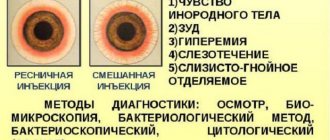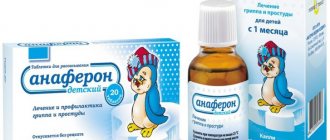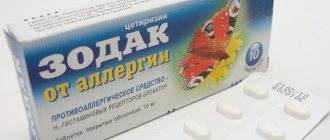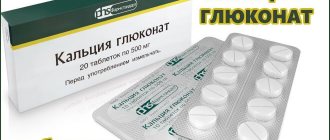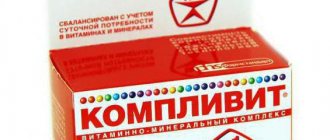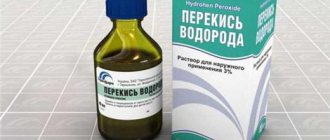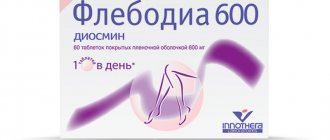For the harmonious development of a child, it is important that he receives vitamins and minerals, and that his body absorbs them well. To prevent and treat calcium-phosphorus metabolism disorders and vitamin D3 deficiency, newborn babies are prescribed appropriate medications. One of them is Vigantol oil solution. We will tell you everything you need to know about the release form and its composition, indications and contraindications, side effects in this article. Below, for your information, are instructions for using Vigantol for the prevention and treatment of rickets, as well as a list of popular analogues of the drug.
Pharmacokinetics and pharmacodynamics
The components of Vigantol drops are involved in the regulation of phosphorus and calcium metabolism, and also replenish the deficiency of vitamin D3. While taking the drops, the process of calcium absorption in the intestinal mucosa is enhanced. The drug improves bone mineralization, thus strengthening them. Also, the components of the product improve the functioning of the parathyroid glands.
After taking the drops, colecalciferol is absorbed in the small intestine and comes into contact with alpha2-globulins and albumins. The substance accumulates in fat cells, bone tissue, skeletal muscles, adrenal glands and kidneys. Its maximum concentration in the blood is observed on average after 5 hours. Colecalciferol passes into breast milk and through the placental barrier. It is excreted from the body in bile and through the kidneys in urine.
Comparison of Vigantol and Aquadetrim
Both drugs contain the same substance - cholecalciferol, so they have almost the same effect. The amount of vitamin D3 in Vigantol is greater, so the risk of overdose increases. You need to carefully calculate its dose. The similarities and differences between the drugs do not end there.
Similarities
Both drugs are available in the form of drops and should not be used without consulting a doctor. They are contraindicated for diseases of the genitourinary system and kidneys. They have almost the same side effects.
What is the difference
Vigantol is prohibited during pregnancy and breastfeeding. Aquadetrim, on the contrary, is important to take during this period. Also, the latter drug is used for many diseases, and Vigantol greatly limits their list. This medicine can only be purchased with a doctor's prescription, and Aquadetrim is freely sold in pharmacies.
Many parents are afraid to give this medication to their children, but the concentration of alcohol in the drops is extremely low, so there is no harmful effect on the child’s body.
The concentration of the main component in Vigantol is 20,000 IU, in Aquadetrim - 15,000 IU. The first drug is produced in Germany, the second in Russia.
Aquadetrim is an aqueous solution that is absorbed 6 times faster than its oil counterpart, and can be used even by children with insufficient bile production. Vigantol is absorbed more slowly, and pediatricians do not prescribe it to patients with liver disease, because the medication is poorly absorbed if there is little bile. But the oil preparation increases the bioavailability of the vitamin - its loss when used by the body is insignificant.
What is more effective?
Both drugs are highly effective. When used in accordance with the instructions, the pharmacological effect specified by the manufacturer is ensured.
Which is cheaper?
The average price of Vigantol is 345 rubles, Aquadetrim is 204 rubles.
Indications
Vigantol drops are used for the treatment and prevention of rickets, as well as:
- as maintenance therapy in the treatment of osteoporosis;
- to prevent vitamin D deficiency in people at risk. Risk factors: condition after removal of part of the stomach or intestines, biliary cirrhosis of the liver, malabsorption syndrome, chronic diseases of the small intestine;
- for the treatment of pseudohypoparathyroidism, hypoparathyroidism.
Vigantol drops are effective for osteomalacia if it develops against the background of a failure of mineral metabolism, long-term immobilization after injury, or while following a diet in which dairy products are prohibited.
Vigantol or Aquadetrim – Komarovsky
Komarovsky does not give preference to any of these drugs. Moreover, he generally questions the need for children to take vitamin D.
A two-hour walk in sunlight is enough to cover the daily requirement for calciferol, which is synthesized in the skin under the influence of ultraviolet radiation.
Komarovsky about rickets. The pediatrician claims that symptoms of true rickets are extremely rare in children. They need synthetic vitamin D only in cloudy weather and in regions with short daylight hours.
As for the choice of a specific drug, both Vigantol and Aquaderim contain the same active ingredient. Therefore, parents should build on the child’s individual reaction to each of these medications.
Contraindications
Reception of drops is limited when:
- excess calcium in the blood and urine;
- calcium nephrourolithiasis;
- excess vitamin D;
- renal osteodystrophy in combination with high levels of phosphorus in the blood;
- thyrotoxicosis;
- hypersensitivity to substances contained in the product.
Conditions and diseases for which drops are used with caution:
- atherosclerosis;
- kidney failure, heart failure;
- organic heart disorders;
- sarcoidosis;
- diseases of the liver, kidneys, both acute and chronic;
- diseases of the gastrointestinal tract;
- hypothyroidism.
Read more Instructions for Hilabak eye drops
The drug is prescribed with caution to pregnant women, breastfeeding women and people who are simultaneously taking other medications with vitamin D.
Composition and release form
| Oily solution for oral administration | 1 ml (about 40 drops) |
| colecalciferol | 0.5 mg |
| (corresponds to 20,000 IU vitamin D3) | |
| excipients: triglycerides - 939.5 mg |
in dark glass dropper bottles of 10 ml; 1 bottle in a cardboard pack.
The active component of the drops, which is responsible for the therapeutic effect, is colecalciferol. Additionally, the drug contains medium chain triglycerides. Externally, the product has the appearance of an oily, viscous solution with a slightly yellowish color. Vigantol is produced in 10 ml glass bottles with a dropper stopper to make the drug convenient to dose.
Instructions for use of Vigantol drops
Before taking, the drops are mixed with any liquid at room temperature (milk, formula, water, juice, tea, etc.). To prevent rickets, full-term infants over 7 days of age are advised to take 1 drop every day. For babies born prematurely, 2 drops, then the dosage is reduced as prescribed by the pediatrician. Children should take Vigantol for 1-2 years of life. For the treatment of rickets and osteomalacia, 2 to 8 drops per day are indicated, the exact number of drops is determined by the doctor.
For the treatment of pseudohypoparathyroidism, hypoparathyroidism, 15 to 30 drops per day are prescribed. Their exact amount depends on the level of calcium in the plasma, according to which the dosage is adjusted during treatment. To reduce the likelihood of diseases associated with vitamin D3 deficiency, 1-2 drops per day are prescribed. For malabsorption syndrome, 5-8 drops per day are indicated.
Interaction with other drugs
Studies have shown that when taking the drug simultaneously with glucocorticosteroids (Prednisolone, Dexamethasone) and anti-tuberculosis antibiotics (Isoniazid, Rifampicin), the therapeutic effect is reduced. The combination of Vigantol with thiazide diuretics (Hydrochlorothiazide) can lead to an increase in calcium levels. When prescribing Vigantol, the doctor must take these features into account.
If a newborn undergoes long-term therapy with the use of antacids, which contain magnesium and aluminum ions, excess of these elements are formed when taking the drug, which can cause intoxication of the body. Particular caution should be exercised when taking Vigantol if the baby is diagnosed with chronic renal failure.
When treating heart diseases with glucosides, vitamin D3 can provoke an increase in their toxic effects and lead to hypercalcemia. An experienced pediatrician is well aware of the effects of vitamin D3 and can easily make the necessary changes in the treatment process. The child is regularly given an ECG, the amount of calcium is monitored, and the dose of heart medications is adjusted.
Side effects
Negative manifestations can arise from different organs and systems. From the digestive system:
- decreased appetite;
- bowel dysfunction (constipation, diarrhea);
- nausea;
- bloating;
- abdominal pain.
On the part of the heart and blood vessels, increased blood pressure and arrhythmias are possible. Side effects from the musculoskeletal system include pain in the muscles and joints.
Metabolic disorders are manifested by an increase in the level of calcium in the blood and urine (occurs when the dosage or duration of the drops is exceeded). Allergic manifestations are itching, urticaria, rash. Other side effects may include: headache, impaired kidney function.
A few words about why babies need vitamin D
Vitamin D is a biologically active substance:
- Cholecalciferol - (vitamin D3) is produced in the skin under the influence of ultraviolet radiation when exposed to the sun and can be ingested by the body with food.
- Ergocalciferol - (vitamin D2) comes exclusively from food (limited types).
Vitamin D3 is one of the most important substances necessary for a rapidly growing body, regulating phosphorus-calcium metabolism.
Thanks to this vitamin, the mineralization of the skeleton occurs, and the child’s bones actively grow. The baby develops good posture, a correct physique, his limbs grow straight and beautiful. In addition, the vitamin strengthens the immune system, helps you get sick less and cope with colds more easily.
With a lack of this important biologically active substance, rickets can develop, a rare disease in our time that can affect children under three years of age who are in the active growth phase.
The pathology is associated with vitamin D deficiency and a disorder of phosphorus-calcium metabolism, which causes specific damage to bone tissue.
As a result, the child’s stomach becomes bulging, and the legs may become curved, acquiring an X- or O-shape. These changes are irreversible, so the prevention of rickets must be taken seriously.
Children born in the autumn-winter period, as well as those born with low birth weight (which often happens when born before the due date), are more vulnerable to rickets.
The risk of developing rickets is also increased in children living in regions with reduced solar activity. In these cases, taking vitamin D is definitely justified.
You can suspect signs of vitamin deficiency by the presence of the following symptoms:
- Sweaty palms and feet.
- A bald spot on the back of a child's head (hairs are rolling out).
If parents see similar phenomena in their child, they must inform the pediatrician about it.
The main active component of the product (cholecalciferol) serves as a stimulant, ensuring the active introduction of calcium into bone tissue. Thanks to it, the correct formation of bones in the child occurs. Cholecalciferol facilitates absorption and acts as a skilled conductor of vitamin D3 into the skeletal system and connective tissues of a small patient.
The medicinal components in the required quantities are quickly absorbed by the child’s body and begin to correct the situation. Excess drug is easily excreted in feces; it does not accumulate in tissues and organs, thereby eliminating negative reactions.
To achieve a positive therapeutic effect, a certain amount of the drug must accumulate in the body, so treatment is a course of treatment. The duration of the course is determined based on the degree of damage to the child’s body from vitamin deficiency. Reducing the dosage and duration of use is determined by tests and the general condition of the baby.
As a prophylactic agent and for the treatment of rickets, the drug can be prescribed from the second week of a newborn’s life. For babies born in winter, taking the product is especially important. Low amounts of sunlight at this time of year reduces the natural supply of vitamin D3. It has to be replenished with the help of medications. According to the instructions, the usual dosage of the medicine by age looks like this:
- for full-term babies – 1 drop per day;
- for premature babies – 2 drops per day.
The total amount of the drug entering the child’s body during the year is 20 ml (for preventive purposes). After a year, the dosage varies according to the child’s condition. If the baby is diagnosed with softening of bone tissue (osteomalacia), the medicine is given in a dosage of 8 drops per day. With hypoparathyroidism, the daily dose is increased to 15-30 drops.
Overdose
If the dosage of drops is regularly exceeded or the duration of their use, symptoms of overdose develop, associated with an increase in the level of vitamin D3. Its signs are divided into early (due to increased calcium in the blood) and late. The first include the following symptoms:
- bowel dysfunction in the form of constipation or diarrhea;
- headache;
- thirst;
- dry mouth;
- weight loss up to the development of anorexia;
- metallic taste in the mouth;
- severe fatigue;
- nausea, sometimes vomiting;
- dehydration of the body;
- increased calcium levels in the blood and urine;
- frequent urination, especially at night.
Late manifestations of excess vitamin D3 are:
- pain in bones, muscles, stomach;
- rise in blood pressure;
- eye sensitivity;
- redness of the conjunctiva;
- cloudy urine;
- itchy skin;
- weight loss;
- nausea and vomiting;
- pancreatitis;
- changes in mood and psyche.
Chronic overdose is manifested by the accumulation of calcium in soft tissues, lungs, blood vessels, and kidneys. Kidney and heart failure develop, and growth in children is impaired.
Read more Ophthalmoferon eye drops: instructions for use for adults and children
Treatment is prescribed depending on the severity of overdose symptoms, taking into account the level of calcium in the blood. Therapeutic measures:
- stopping taking Vigantol drops;
- prescribing a diet with limited calcium-containing foods;
- drinking plenty of water;
- taking ascorbic, pantothenic acid, retinol, riboflavin, thiamine;
- prescription of glucocorticosteroids, furosemide, electrolytes.
In severe cases, hemodialysis is performed and calcitonin is administered. There is no specific antidote to treat overdose.
Characteristics of Vigantol
This drug is available in the form of an oil solution taken orally.
Its active ingredient is colecalciferol (vitamin D3), which is an antirachitic agent. An additional chemical compound is medium chain triglycerides. The main component has the following properties:
- normalizes the exchange of calcium and phosphorus;
- provides bone mineralization;
- enhances the absorption of calcium in the intestines and the reabsorption of phosphates in the kidneys;
- Helps the normal functioning of the parathyroid glands.
Due to a lack of calcium, bone fragility can develop, leading to bone fractures. Using Vigantol in the required doses reduces this risk. In addition, the drug is used for the treatment of rickets, pseudohypoparathyroidism, hypoparathyroidism, osteochondrosis, osteomalacia, as well as for maintenance therapy of osteoporosis.
Contraindications include:
- hypersensitivity to the drug;
- thyrotoxicosis;
- renal osteodystrophy with hyperphosphatemia;
- hypervitaminosis D;
- hypercalcemia;
- hypercalciuria;
- calcium nephrourolithiasis.
Vigantol is used to treat rickets, pseudohypoparathyroidism, hypoparathyroidism, osteochondrosis, osteomalacia.
With caution, the doctor prescribes medication for the following diseases and conditions:
- atherosclerosis;
- hyperphosphatemia;
- sarcoidosis;
- gastrointestinal diseases;
- renal failure;
- liver and kidney diseases;
- organic heart lesions;
- heart failure;
- pregnancy and breastfeeding;
- hypothyroidism;
- phosphate nephrourolithiasis.
Treatment, depending on the disease, can last up to 1 year.
According to the instructions for use, this drug can cause the following side effects:
- flatulence, loss of appetite, constipation or diarrhea, nausea, abdominal pain;
- myalgia, arthralgia;
- arrhythmia;
- increased blood pressure;
- itching, urticaria, rash;
- headache.
The medication does not interact with food. If such a need arises, then it is replaced with analogues: Videhol, Aquadetrim.
This is a medicine that comes in the form of an aqueous solution and is administered orally. The drops have a pleasant taste and an anise-like smell. The main component is colecalciferol (vitamin D3). The drug is prescribed for rickets, glucose-phosphatamine diabetes, hypoparathyroidism, tetany, hypocalcemia, osteoporosis, hypophosphatasia, osteomalacia.
Aquadetrim is an approved medication for newborns and infants with a lack of vitamin D3.
The medicine is approved for newborns and infants with a lack of vitamin D3. In addition, it is used in complex therapy for cirrhosis, alcoholism, liver failure and obstructive jaundice.
Contraindications:
- excess vitamin D3;
- renal failure;
- severe kidney disease;
- kidney stone disease;
- hypercalciuria;
- hypercalcemia;
- individual intolerance to the components of the drug;
- pulmonary tuberculosis;
- age up to 1 month.
Sometimes the medication leads to side effects. Constipation, dry mouth, nausea, sleep disturbances, fever, increased urination, loss of appetite, and weakness may occur. If necessary, use analogues: Vigantol, Cholecalciferol, Videhol.
Drug interactions
Long-term treatment with Vigantol while taking antacids that contain magnesium and aluminum increases their level in the blood, resulting in an increased likelihood of developing intoxication. Reduce the effectiveness of drops - Calcitonin, Plicamycin, Isoniazid, Rifampicin and biphosphates. Absorption of the active ingredient in the gastrointestinal tract is reduced by Colestipol and Cholestyramine. In this case, the dose of the drug must be increased.
Phosphorus-containing medications enhance the absorption of Vigantol, so their combined use can cause hyperphosphatemia. When taking drops with sodium fluoride together, you should adhere to an interval of 2-3 hours between doses. Taking Primidon, Phenytoin, and barbiturates increase the body's need for vitamin D3, as they accelerate the process of its biotransformation.
When taking glucocorticosteroids simultaneously, the effectiveness of Vigantol is reduced. When taking cardiac glycosides, their toxic effect increases, and hypercalcemia may develop. In this case, it is recommended to monitor the amount of calcium in the blood, ECG readings, and adjust the dosage of glycosides.
The drug can be combined with vitamin D analogues and metabolites only in extreme cases, according to strict indications with monitoring of calcium levels. The likelihood of developing excess calcium increases when treated with benzodiazepines and thiazide diuretics (they delay the excretion of calcium in the urine).
Brief description of Aquadetrim
An oil solution of vitamin D, produced in Germany, is positioned as a new generation vitamin preparation. Only medium chain triglycerides are used as additional components.
This significantly reduces the likelihood of complications not related to the action of vitamin D. But this composition impairs the absorption of the drug and makes it ineffective in the absence of bile in the intestines.
Benefits of Vigantol
- less likely to cause allergic reactions;
- does not contain alcohol;
- no need to reheat before use.
Disadvantages of Vigantol
- higher risk of overdose;
- poorly absorbed in children with insufficient bile production.
Buy Vigantol at a bargain price
An aqueous solution of vitamin D, produced in Poland. Normally, this component is not soluble in water, so Aquadetrim contains benzyl alcohol and a number of other chemical compounds.
They help mix vitamin D and water to form an aqueous suspension, but the large number of ingredients increases the risk of side effects.
On the other hand, the absence of binding to fat improves the absorption of the drug and makes it indispensable for patients with disorders of the synthesis and secretion of bile.
Advantages of Aquadetrim
- easily absorbed from the intestine;
- the presence of bile in the intestine is not necessary for absorption;
- lower risk of overdose;
Disadvantages of Aquadetrim
- It is advisable to reheat before use;
- contains alcohol;
- has a specific taste;
- more often causes allergies.
Buy Aquadetrim at a bargain price
Analogs
The drug has many analogues that have the same indications for use and a similar composition. The most popular are:
- Aquadetrim.
- Complivit Aqua D3.
- Vitamin D3.
- Ultra-D.
- Calcemin.
- Detrimax Vitamin D3.
- D3-Droplet.
- Colecalciferol.
- Osteocea.
Also, Vigantol drops can be replaced with Natekal D3, Calcium-D3 Nycomed (Forte), Ostalon Calcium-D.
Read more How to take Guttalax drops: composition, instructions and reviews
Reviews about Vigantol
On medical and children's forums there are many reviews about drugs that are prescribed for vitamin D3 deficiency. Parents share their experience of using this or that remedy, and are interested in what medicine they give to other children.
According to many users, pediatricians prescribe an aqueous solution of Aquadetrim to their children. Moreover, in some cases, upon examination by an orthopedist, such children are diagnosed with rachitic changes. After this, drugs are prescribed in oil solutions, for example, Vigantol or vitamin B2-ergocalciferol.
As reviews of Vigantol show, this particular drug is often prescribed for newborns. As a result, no pathological changes in the bone structure are detected in them for 1-2 years. Also, despite the high probability of developing side effects, descriptions of adverse reactions while taking Vigantol are not presented online.
Until what age should vitamin D be given?
Vitamin D intake should end when the baby reaches one year: by this time he already knows how to move independently, does not hide under the hood of the stroller during walks, so there is a high chance of receiving the necessary dose naturally. The diet is also enriched: now you can give the necessary foods as complementary foods.
On the other hand, vitamin D for newborns and one-year-old children is just the beginning. Older people also need it, so the doctor often decides to continue taking the drug for up to two to three years, based on the individual developmental characteristics of the baby, his state of health and living conditions.
In any case, children additionally take vitamin D up to a maximum of 3 years of age, since their body is ready to independently produce it in sufficient quantities and receives it through targeted nutrition and walks in the sun. In the fourth year of life, if necessary, pediatricians prescribe complex medications, including vitamin D.
Opinions about the drug
Reviews about Vigantol are varied, but mostly positive. Experts recommend it as a preventive measure and as an effective treatment even for the youngest patients. Proper use helps to avoid the development of serious pathologies or cure existing ones. But it should be remembered that, like any given remedy, it requires certain rules of administration.
Parents of children suffering from rickets noted noticeable improvements in their child’s health after a course of therapy. In rare cases, the effect was little noticeable or absent due to an incorrectly selected drug. Often, full recovery occurs only after a person has completed the entire course of therapy.
Most parents are satisfied with the results, even despite how many side effects are indicated in the instructions. They occur quite rarely. If a child feels unwell after taking the drug, you should inform your pediatrician.
An important factor that is described when compiling a review is the price of the medicine, which is not considered high for a product thanks to which the patient experiences positive dynamics in treatment.
To avoid the development of pathological processes, it is better to lead a healthy and active lifestyle. Proper balanced nutrition, moderate stress on the body and moderate exposure to fresh air will help get rid of many diseases and it is possible that you will not need to take any medications, but in certain cases medication will be prescribed to support the body.
Reviews
According to reviews, the Vigantol dispenser works very well and dispenses the required amount of drops (it doesn’t leak, and you don’t need to shake it either). Thus, it is difficult to make a mistake in the number of drops and give the child a larger dose than necessary. Due to the absence of alcohol, the drops do not sting and eliminate negative effects, which is positively assessed by many mothers who are against any alcohol-containing substances entering the child’s body in any dosage.
Advantages: supports the body with the necessary vitamins. Disadvantages: none. I am a mother and a pharmacist by training. Appreciated by Vigantola. I also purchased Aquadetrim according to a doctor’s indication when the child was born, but later switched to the oil form. The composition here is more concise, without additional components..
Advantages: if there is no sun, you can get vitamin D. Disadvantages: the effect is not clear. Vigantol, like Aquadetrim, was prescribed to us by the doctor when the child was about three months old. At first they prescribed one drop a day, then they increased it to three. A masseuse I know said that it is possible to give more in winter, since we have constant smog over the city due to factories, which does not allow the sun to pass through.
Advantages: oil-based, without alcohol in the composition, suited us, reasonable price. Disadvantages: none. The bottle is more convenient; if you need one drop, it comes out into a spoon for administration. We did not find any sleep disorders in the baby or rash when taking the drug; it suited the baby.
Loving, caring parents dream of a healthy and beautiful baby who develops as well as his peers. Therefore, if, when choosing a drug to replenish the body with vitamin D, moms and dads decide on Vigantol, we hope our advice will help them use the product correctly for its intended purpose.
Features of the dosage form of Vigantol
The drug acts as a regulator of calcium-phosphorus metabolism in the patient's body. Its intake helps to replenish vitamin D deficiency, enhances the reabsorption of phosphorus compounds in the kidneys, and increases the ability of the gastrointestinal tract to absorb calcium. Taking Vigantol is indicated for conditions accompanied by violations of the above body functions:
- osteomalacia is a pathological process associated with insufficient bone mineralization;
- spasmophilia - a disease associated with increased excitability of nerve and muscle tissues, manifested through convulsions and spastic conditions, often associated with rickets;
- rickets – disturbances in the process of formation and mineralization of bones in a child associated with vitamin D deficiency;
Vigantol is prescribed for vitamin D deficiency in newborns.
- hypoparathyroidism - the diagnosis must be accurate, since in case of hypothyroidism the drug is recommended to be used only if indicated with extreme caution;
- dairy-free diet - the drug is required to compensate for mineral deficiency due to avoidance of dairy products;
- pseudohypoparathyroidism;
- osteoporosis of various etiologies;
- chronic pathologies of the small intestine;
- liver cirrhosis (biliary form);
- recovery period after resection of the small intestine or stomach.
Currently, pharmaceutical companies produce a number of drugs that increase vitamin D content and calcium absorption, many of them (including Vigantol) can be used for children from the first days of life. The most popular analogue of the drug in question is Aquadetrim solution. Unlike Vigantol, it is not oil-based, but water-based.
To prevent and treat rickets, doctors prescribe vitamin D3 in solutions. Vigantol is an oil solution of this vitamin, since fats are necessary for complete absorption, that is, it is fat-soluble.
It should be taken into account that in infants the mechanisms for breaking down fats are not yet fully developed, so absorption of the drug may occur slowly.
For this purpose, some pediatricians (based on reviews from mothers) recommend that parents deviate slightly from the instructions for the drug and take two-day breaks after five days of drop therapy.
This method of use is based on ensuring that the resulting droplets are better absorbed by the body and there is no overdose effect due to the accumulation of excess vitamin.
The German drug Vigantol is sold by the manufacturer in a 10 ml brown glass bottle.
The bottle is equipped with a very convenient dispenser - a pipette, which accurately and slowly measures the required number of drops if you tilt it at an angle of 45 degrees.
Vigantol solution intended for oral administration has the following characteristics:
- oil;
- transparent;
- slightly yellowish;
- viscous;
- odorless and tasteless.
Alcohol-containing formula is not included in the composition.
The pediatrician decides how to take vitamin D for infants. Drops are usually prescribed from five weeks of age. Premature babies – earlier, when they reach two weeks. The instructions for use advise drinking it for a month, then taking a break for a week.
When the baby turns one year old, some pediatricians believe that supplements can be abandoned if there are no signs of rickets. The baby's diet becomes varied, complementary foods are introduced, which partially compensate for the shortage. But the majority believes that it is better to extend the use of supplements until two years of age, when the child receives adequate nutrition and takes a long walk outside in the morning. Walking in the evening is not effective for vitamin synthesis.
Stop taking at the age of three years. If the child has developed normally, after this time there is no risk of developing rickets.
In childhood
In children, Vigantol is used to prevent rickets. According to the instructions for use, the solution can be given from two weeks of age until the end of the first year of life. During the second year of a child's life, the drug may be needed in winter. For young children, the solution is given with a teaspoon of water, milk or baby food. It is not advisable to add them to food, because the child may not finish the portion, which will affect the effectiveness of the medicine. Treatment of rickets consists of taking 2-8 drops of the drug per day for a year.
How to take Vigantol Methods and dosages
The drug in question should be taken only as prescribed by a doctor. Also, before using it, you must carefully study the attached instructions. It states that the drug "Vigantol" is prescribed to newborns along with mother's milk or some other liquid. To do this, the solution in the required amount is mixed with food for the baby in a small spoon.
To prevent a disease such as rickets, healthy and full-term children from two months of age are prescribed 1 drop of the drug every day. Take this medicine for five days. After the specified time, take a two-day break.
It is highly recommended not to give medication to children from one to two years old during the summer months of the year.
For premature babies, from the 10th day of life, a dose of 2 drops is prescribed (every day). This treatment is continued throughout the day, with two-day breaks. An exception for such therapy is also the summer months.
How to use the drug “Vigantol” to treat rickets? In this case, the drops are taken in higher doses. For example, children from the 10th day of life are allowed to give 2-8 drops every day.
"Vigantol" for adults is also prescribed by the attending physician. Previously, the patient undergoes a medical examination, during which the indicator of vitamin D3 deficiency is determined. By the way, its level should be monitored throughout the entire therapy.
pharmachologic effect
This drug is safe to give to newborns because it is absorbed into the walls of the gastrointestinal tract. Next, the components interact with globulins and albumins. Subsequently, colecalciferol accumulates in the liver, bone tissue, kidneys and myocardium.
The maximum concentration of components in infants is observed five hours after consumption. Over time this value decreases. However, during this period it is possible to achieve the necessary effect of therapy. The component is able to penetrate the baby’s body even through the placenta. Subsequently, the remains of decomposition may be excreted in breast milk. That is why it is right to stop breastfeeding during this period. Later, inactive metabolites accumulate in the kidneys and liver. Bile or urine is used to remove the remains of decomposition.
The drug is recommended for children who are diagnosed with spasmophilia, rickets or osteomalacia.
Taking the drug in infants
During pregnancy
Doctors prescribe Vigantol with caution for women during pregnancy and breastfeeding. When carrying a child, an adequate supply of vitamin D3 to the mother's body is required. If the dose of colecalciferol is exceeded, there is a risk of developing hypercalcemia and transplacental penetration of metabolites into fetal tissue, which results in a teratogenic effect. The child will be born with mental and physical disabilities, aortic stenosis.
The drug Vigantol is recommended to be taken with extreme caution during the period of breastfeeding the baby naturally, as well as during the period of bearing a child, since the medication can penetrate into breast milk, as well as through the placenta. The drug is prescribed only as prescribed by the attending physician, and it is necessary to monitor the amount of cholecalciferol in the body to avoid excess.
Storage conditions
According to the instructions, Vigantol should be stored in a dry, well-ventilated room, out of reach of children and light, at a temperature varying between 15-25 °C.
The drug is dispensed from pharmacies with a doctor's prescription and has a shelf life of five years. After the expiration date, the drug must be disposed of.
The drug can be purchased at a pharmacy with a doctor's prescription. The main ones are in Norway and Germany. The final cost of the product is influenced by the territorial location of the pharmacy. In general, in Russia the price for Vigantol ranges from 170 to 200 rubles. In Moscow the highest cost of the drug is noted, and in the provinces you can buy the drug at the lowest price.
The storage conditions indicate that the drug should be kept in a dark place at a temperature no higher than 25 degrees and no lower than 15 degrees. The shelf life of the medicine is 5 years. The economical consumption of the oil solution and long shelf life make it possible not to purchase the medicine in large quantities. The low price ensures the availability of the drug for all segments of the population.
Vigantol is available from pharmacies with a doctor's prescription. According to the manufacturer's recommendations, it should be stored at a temperature of 15-25 ºС in a place protected from sunlight. If these recommendations are followed, the shelf life of the drops is 5 years.
Found an error in the text? Select it and press Ctrl Enter.
Vigantol, according to the instructions, is one of the prescription vitamin medications with a shelf life of up to 5 years, provided that it is stored in accordance with the conditions recommended by the instructions (at a temperature not exceeding 25 ° C).
How to take: special instructions
The drug is taken orally . It must first be dissolved in milk or another type of liquid. The required amount of medicine is measured by a built-in dropper.
Taking the medicine is indicated after meals . For better absorption of cholecalciferol, it is recommended to include plant foods and fats in the diet.
During treatment, the level of vitamin D in the body is monitored. If necessary, the dosage is adjusted. This is done under the strict supervision of a specialist.
Sometimes individual intolerance to the drug may develop.
What you need to know about the composition of the drug
1 ml of solution (about 30 drops) contains the active ingredient colecalciferol, 0.5 mg which corresponds to 20,000 IU of vitamin D3.
The drug also contains excipients such as triglycerides - these are components of natural oils that are best absorbed and digested, therefore they are suitable even for patients who are unable to process regular fats and oils due to chronic disorders of the digestive system or removal of part of the small intestine. Medium chain triglycerides occur naturally in milk fats and in palm and coconut oils.
Thus, the oil-forming substance of natural origin and vitamin D (fat-soluble) are absorbed together with this component much more efficiently.
What to be wary of and what not to be aware of
As for allergic skin reactions, which mothers are usually afraid of, they practically do not occur when Vigantol is used in young patients.
The main and only disadvantage of the drug is that an overdose of Vigantol is very dangerous, since an increase in triglyceride levels increases the risk of heart and vascular disease, as well as the development of acute pancreatitis.
Vigantol accumulates in the tissues of the body, unlike water-based drug analogues, which are not so well absorbed, but nevertheless, in case of an accidental overdose, their excess quickly leaves the body in the urine.
That is why pediatricians, knowing about the high effectiveness of Vigantol, are more willing to prescribe, for example, Aquadetrim in order to avoid unforeseen circumstances and complications due to the inattention of negligent parents.
Why might this be dangerous? The fact is that an overdose of vitamin D is even worse than its deficiency.
Infants may experience muscle cramps, difficulty breathing and a slow heart rate.
The incidence of adverse reactions is considered unknown because it has not been studied.
To avoid any complications, it is enough to strictly approach the dosage of the drug.
Indications and symptoms of vitamin deficiency
Vigantol oil solution is prescribed to patients mainly for conditions caused by vitamin D deficiency. In addition, it is taken when there is a violation of the metabolism of calcium salts and phosphoric acid in the body. Indications include:
- childhood rickets is a pathology caused by a lack of vitamin in the child’s body and a decrease in the amount of calcium in the blood, as a result of which bone strength deteriorates;
- osteomalacia - softening of bone tissue in patients of different ages due to impaired metabolism of mineral salts;
- female osteoporosis during menopause - leaching of calcium salts from bone tissue due to a decrease in the level of female sex hormones;
- spasmophilia - the appearance of seizures due to a decrease in the amount of calcium ions, which disrupts the process of nerve impulses;
- hypoparathyroidism - a violation of the activity of the parathyroid glands, against the background of which the level of their hormones decreases;
- complex therapy of acne and psoriasis;
- prevention and treatment of hypovitaminosis.
https://youtube.com/watch?v=Mt9W-9yJg8Q
In women, such symptoms can manifest themselves especially noticeably, mainly after 40 years. In rare cases, vitamin deficiency can cause hypovitaminosis, accompanied by increased blood pressure, diarrhea, cramps, joint pain or vomiting.
Dangers of Overdose
According to the instructions, Vigantol is used orally, in a spoonful of milk or other liquid.
But some breastfeeding mothers drip the drug onto the nipple before feeding, as they believe that some vitamin may remain on the spoon.
Experienced mothers do not recommend dripping into a child’s mouth, because you can mistakenly overdose the drug.
To prevent rickets, healthy full-term babies are prescribed Vigantol, starting from the second week of life, 1 drop (which is about 667 IU of vitamin D3) daily.
Babies born prematurely (premature) are prescribed 2 drops (1334 IU of vitamin D3) daily from the 2nd week of life.
The annotation states that the drug can be taken both in the morning and in the evening and does not depend on food intake, but some pediatricians believe that the drug will be more effectively absorbed in the first half of the day, immediately after feeding.
Vigantol is recommended to be given to a child of the first and second year of life, mainly in the winter months.
It is not necessary to store the bottle in the refrigerator, since the oil solution does well at room temperature. The drug lasts for approximately six months.
Pediatricians advise mothers to give their children Vigantol in those months whose names contain the letter “P”.
It is necessary to give a small child vitamin D drops as prescribed by the pediatrician. It is necessary to read the instructions for use and determine the time of administration - morning or evening. Typically, the rules require taking the supplement in the first half of the day.
The dosage prescribed for prophylactic purposes is 500 IU per day. According to the doctor’s recommendation, children after one year of age increase to 1000 IU. Premature babies receive different doses. You can learn more about how to properly give vitamin D to a child under one year of age in another article.
Therapeutic doses are higher. For rickets, up to five thousand international units per day are used. They start with two thousand, gradually increasing the amount; at the same time, the level of calcium in the blood must be monitored so that an overdose of the vitamin does not occur. The course is not carried out for long, for a month, then, according to the rules, there is a break for seven days.
Cholecalciferol (D3)/ergocalciferol (D2) Form of substance
Decimal places as a result
Convert
Conversion of IU ⇄ g/mg/mcg (developed by pharmacists and doctors based on reliable data)
There are two types of overdose: acute and chronic. Acute occurs:
- after a single use of a high dose of the drug, more than twenty thousand units, due to careless storage of the drugs, when the child gains independent access;
- after consuming high doses for three weeks.
Chronic overdose develops over a long period of time, gradually, when parents give as much vitamin D as the baby cannot absorb. Mothers do not always correctly assess the condition of the baby, cannot understand the signs of excess, and confuse them with symptoms of deficiency.
An acute condition requires emergency medical attention. Symptoms:
- lethargy, drowsiness;
- lack of appetite, repeated vomiting;
- the skin and mucous membranes are dry, the child is thirsty;
- baby urinates frequently;
- convulsions;
- loss of consciousness.
If symptoms appear, you need to stop taking the vitamin and contact a medical facility for advice.
- the child is capricious, lethargic, sleep and rest patterns are disturbed;
- weight loss;
- kidneys stop functioning normally - frequent urination, lower back pain;
- the skin becomes dry, turgor is reduced;
- dyspepsia – nausea, frequent regurgitation, unstable stool;
- convulsions, muscle twitching;
- the child complains of pain in the legs and arms.
Dr. Komarovsky believes that an excess of the vitamin is more dangerous than a deficiency. Recommends not to exceed the preventive norms for cholecalciferol intake.
What are the benefits and harms of cholecalciferol for a baby?
Fat-soluble vitamins D are vital substances. The most important one, called cholecalciferol, is formed in the skin under the influence of sunlight. And D2, ergocalciferol, which comes from plant foods. The main function is to ensure adequate processing of calcium and phosphorus in the intestines. It also takes part in the synthesis of hormones, metabolic processes, and strengthening the immune system.
California Gold Nutrition, Vitamin D3, Children's Drops, 10 mcg (400 IU), 0.34 fl oz. (10 ml)
512 rub.
Buy More details iherb.com
Vitamin D is necessary for newborns for timely development:
- skeletal bones;
- closure of the fontanel;
- tooth formation;
- development of nerve fibers, strengthening of the myelin sheath, which is responsible for transmitting impulses;
- development of muscle tissue, support of muscle contraction;
- strengthening the immune system;
- support insulin synthesis.
A lack of calciferol in infants manifests itself as signs of rickets. At risk are babies who are rarely exposed to the sun and who do not receive adequate nutrition from their mother.
Prophylactic medication is prescribed at the age of five weeks. Premature babies are added to the diet three weeks earlier. Infants are at risk for the following reasons:
- region of residence – children born in northern latitudes;
- season - those born in autumn, winter;
- physiological status – premature, low body weight;
- the ability to produce vitamin in the epidermis - infants with dark skin color;
- environmental situation - living in cities with high gas pollution.
Use without consultation with a pediatrician may harm the baby. Dr. Komarovsky believes that excess causes more harm than deficiency. The consequences of an overdose are dire:
- dyspeptic disorders - nausea, vomiting, loss of appetite, constipation, loose stools;
- dysfunction of the respiratory system;
- convulsive syndrome.
Proper use of prophylactic doses will protect the infant from danger. There is no need to take the drug in the following cases:
- timely birth with normal weight;
- birth in the southern regions, in spring and summer;
- fair skin, regular walks outside;
- feeding with mother's milk with a full mother's diet;
- artificial feeding if the mixture contains vitamin D.
About why vitamin D is needed for the health of babies - in the video of Dr. Komarovsky:



